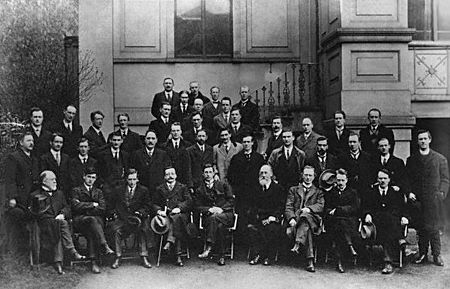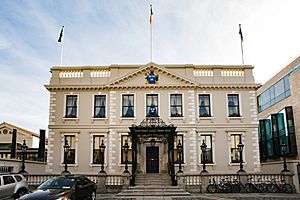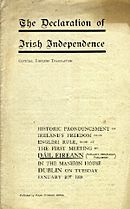First Dáil facts for kids
Quick facts for kids First Dáil |
|||||
|---|---|---|---|---|---|
|
|||||
| Overview | |||||
| Legislative body | Dáil Éireann | ||||
| Jurisdiction | Irish Republic | ||||
| Meeting place | Mansion House, Dublin | ||||
| Term | 21 January 1919 – 16 August 1921 | ||||
| Election | 1918 general election | ||||
| Government | Government of the 1st Dáil | ||||
| Members | 73 | ||||
| Ceann Comhairle | Cathal Brugha (1919) George Noble Plunkett (1919) Seán T. O'Kelly (1919–21) |
||||
| President of Dáil Éireann | Cathal Brugha (1919) | ||||
| President of the Irish Republic | Éamon de Valera (1919–21) | ||||
| Sessions | |||||
|
|||||
The First Dáil (which means "First Assembly" in Irish) was the very first meeting of Ireland's own parliament. It met from 1919 to 1921. This was the first time the Irish Republic had its own law-making body.
In the 1918 Irish general election, a political party called Sinn Féin won most of the seats in Ireland. They had promised to create a separate Irish parliament. So, on 21 January 1919, these elected members refused to go to the British Parliament. Instead, they gathered in Dublin to form their own assembly, the Dáil Éireann.
At this first meeting, they officially declared Ireland independent. They also agreed to a temporary set of rules for how the new government would work. This important meeting happened on the same day as one of the first fights of the Irish War of Independence. Even though the Dáil didn't order the fighting, it became a symbol of Irish people's desire for freedom. It also gave a sense of purpose to those fighting for independence.
The British government made the Dáil illegal in September 1919. After that, the Dáil had to meet in secret. The First Dáil met 21 times. Its main goal was to set up the new Irish Republic. It started to create the first parts of an independent Irish government. After new elections in May 1921, the First Dáil was replaced by the Second Dáil.
Contents
How the First Dáil Began
In the early 1900s, Ireland was part of the United Kingdom. Irish people were represented in the British Parliament by 105 MPs. Many Irish MPs wanted "Home Rule." This meant Ireland would govern itself but still be part of the UK. A law for Home Rule was passed in 1914, but it was put on hold because of World War I.
The leader of the Sinn Féin party, Arthur Griffith, had a different idea. He thought Irish nationalists should do what Hungarians did. In 1867, Hungarian leaders boycotted the Austrian parliament. They set up their own parliament, which led to Hungary gaining more independence. Griffith believed Ireland should do something similar.
In April 1916, during World War I, Irish republicans started an uprising against British rule. This was called the Easter Rising. They declared an Irish Republic. British forces quickly stopped the uprising. Many leaders were executed, and thousands were imprisoned. However, this event, along with Britain's attempt to force Irish men to join the army, made many more people support Sinn Féin and Irish independence.
The 1918 Election
In the 1918 Irish general election, Sinn Féin won a huge victory. They won 73 out of 105 Irish seats in the British Parliament. In 25 areas, Sinn Féin won without anyone running against them. The election rules had changed, so many more people could vote.
Sinn Féin's election plan promised to create an Irish Republic. They said they would do this by forming "a group chosen by Irish voters" who could "speak and act for the Irish people." Once elected, the Sinn Féin MPs kept their promise.
The First Meeting of the Dáil
Sinn Féin leaders met in early January to plan the Dáil's first session. On January 8, they announced their plan to the public. The British police tried to stop them by raiding Sinn Féin's office. They took copies of the documents for the meeting. This meant the British knew exactly what was going to happen.
The first meeting of Dáil Éireann started at 3:30 PM on January 21, 1919. It took place in the Round Room of the Mansion House, Dublin, which was the home of Dublin's Lord Mayor. The meeting lasted about two hours. The room was full of people who cheered as the Dáil members entered. Many waved Irish tricolour flags.
Many Irish and international journalists were there to report on the event. Outside, the street was crowded with onlookers. Irish Volunteers helped control the crowds, and police were also present. The Dáil had taken steps to be ready if the British authorities tried to raid the meeting.
Twenty-seven Sinn Féin MPs attended the meeting. All elected MPs in Ireland had been invited. However, Unionist MPs and Irish Parliamentary Party MPs refused to come. Sixty-nine Sinn Féin MPs had been elected in total. But 34 were in prison, and eight others could not attend. Those in prison were described as "imprisoned by the foreigners." Michael Collins and Harry Boland were listed as "present" at first. But this was changed later to "absent." They were secretly in England, planning the escape of Éamon de Valera from prison.
Because it was a very important first meeting, everything was done in the Irish language. However, translations of the documents were also read in English and French. George Noble Plunkett opened the meeting. He nominated Cathal Brugha to be the temporary Ceann Comhairle (chairman or speaker). Both of these choices connected the Dáil to the 1916 Rising. Brugha had been badly wounded in the Rising, and Plunkett's son had been executed for signing the Proclamation of the Irish Republic.
Important Declarations and Rules
The Dáil then read and approved several important documents:
- The Dáil Constitution: This was a short, temporary set of rules for the new government.
- The Irish Declaration of Independence: This officially declared Ireland independent.
- The Message to the Free Nations of the World: This asked other countries to recognize Ireland's independence.
- The Democratic Programme: This was a plan for social and economic policies.
These documents stated that the Dáil was the parliament of a free country called the "Irish Republic." The Declaration of Independence confirmed the Proclamation of the Irish Republic from the 1916 Rising. It promised to make this declaration real "by every means." It said that only elected Irish representatives could make laws for Ireland. It also declared that "foreign government in Ireland" was wrong. It demanded that British soldiers leave Ireland. After the Declaration was read, Cathal Brugha said in Irish: "Deputies, you understand from what is asserted in this Declaration that we are now done with England. Let the world know it... For come what may now, whether it be death itself, the great deed is done."
The Message to the Free Nations asked for international support for Ireland. It also asked for Ireland to be allowed to present its case at the Paris Peace Conference. It said that the "state of war between Ireland and England can never be ended until Ireland is definitely evacuated by the armed forces of England." This was a strong statement, almost like a declaration of war.
The Dáil Constitution said the Dáil had "full powers to legislate." It would be made up of representatives chosen by the Irish people. It also set up a government called the Ministry. This Ministry would have a president chosen by the Dáil, and ministers for finance, home affairs, foreign affairs, and defense. Cathal Brugha was chosen as the first temporary president. Éamon de Valera took over as president in April.
How People Reacted
The Dáil's first meeting and its declaration of independence were major news in Ireland and around the world. However, the British government in Ireland tried to stop newspapers from printing the Dáil's declarations.
A British newspaper reported that the British leader in Ireland, Lord French, was "the master of Ireland." It said he alone would decide the country's government. But Lord French's observer at the meeting was impressed. He told French that the Dáil truly represented "the general feeling in the country." The Irish Times, a newspaper that supported British rule, called the events both silly and dangerous.
Irish republicans and many nationalist newspapers saw the meeting as a huge moment. They believed it was the start of "a new epoch." One person there said it was hard to describe the strong feeling in the room. It felt like "great things were happening, even greater things impending." It was a glimpse of "the Ireland of the future."
An American journalist made a very accurate prediction. He said, "The British government apparently intends to ignore the Sinn Fein republic until it undertakes to enforce laws that are in conflict with those established by the British; then the trouble is likely to begin."
The Irish War of Independence Begins

1st row (left to right): L. Ginnell, M. Collins, C. Brugha, A. Griffith, É. de Valera, G. Plunkett, E. MacNeill, W. T. Cosgrave and E. Blythe.
2nd row (l to r): P. J. Moloney, T. MacSwiney, R. Mulcahy, J. O'Doherty, S. O'Mahony, J. Dolan, J. McGuinness, P. O'Keefe, M. Staines, J. McGrath, B. Cusack, L. de Róiste, M. Colivet and M. O'Flanagan
3rd row (l to r): P. Ward, A. McCabe, D. FitzGerald, J. Sweeny, R. Hayes, C. Collins, P. Ó Máille, J. O'Mara, B. O'Higgins, S. Burke and K. O'Higgins.
4th row (l to r): J. McDonagh and S. MacEntee.
5th row (l to r): P. Béaslaí, R. Barton and P. Galligan.
6th row (l to r): P. Shanahan and S. Etchingham.
Members of the Irish Volunteers, a group of armed republicans, believed that the Dáil's election and declaration of independence gave them the right to fight for the Republic. This group soon started calling itself the Irish Republican Army (IRA). The First Dáil became a clear symbol of resistance. It gave a reason for the fighters in the guerrilla war that followed.
On the same day as the Dáil's first meeting, two police officers were killed in an ambush in County Tipperary. This was done by members of the Irish Volunteers. The Volunteers took the explosives the officers were guarding. This action was not approved by the Volunteer leaders or the Dáil. Even though some people were members of both the Dáil and the Volunteers, they were separate groups. Neither group controlled the other.
After the Dáil was formed, steps were taken to make the Volunteers the official army of the new Irish Republic. In January 1919, the Volunteers' newspaper said that Ireland and England were at war. It said the Dáil's founding meant the Irish Volunteers could treat British soldiers and police like an "invading army." In August 1920, the Dáil voted that the Irish Volunteers, as a "standing army," would promise loyalty to the Dáil and the Republic.
The Soloheadbeg ambush and other similar events in 1919 were not meant to start a full war. But that is what they became. This ambush is now seen as one of the first actions of the Irish War of Independence. The Dáil did not officially debate declaring war on the United Kingdom until March 1921. They agreed to give President de Valera the power to declare war when he thought it was best. But he never did.
In September 1919, the British authorities declared the Dáil illegal. After that, it met only sometimes and in different secret places. The Dáil also worked to establish its authority across Ireland. This included setting up its own court system, known as the Dáil Courts. The First Dáil held its last meeting on May 10, 1921. After elections on May 24, the Dáil was replaced by the Second Dáil, which first met on August 16, 1921.
The Legacy of the First Dáil
The First Dáil and the 1918 election are very important in Irish history. Today, the name Dáil Éireann is used for the main house of the modern Irish parliament, the Oireachtas. Each new Dáil is numbered starting from the "First Dáil" of 1919. For example, the Dáil elected in 2020 is the "33rd Dáil."
The 1918 election was the last time the whole island of Ireland voted as one unit. This didn't happen again until elections for the European Parliament over sixty years later. Irish republicans saw Sinn Féin's big win as strong proof that the Irish people wanted a united, independent Ireland. Some republican groups have even claimed that their actions were justified by this 1918 vote.
The First Dáil "created the beginnings of an independent Irish government." It also "provided the people and the power to make peace with Britain and end the war." The Irish state has celebrated the founding of the First Dáil many times. It marks the day when "a constitutionally elected majority of MPs declared the right of the Irish people to have their own democratic state."
Seán MacEntee was the last living member of the First Dáil. He passed away on January 10, 1984, at 94 years old.
See also
- Government of the 1st Dáil
- Members of the 1st Dáil
- Second Dáil
- Third Dáil




